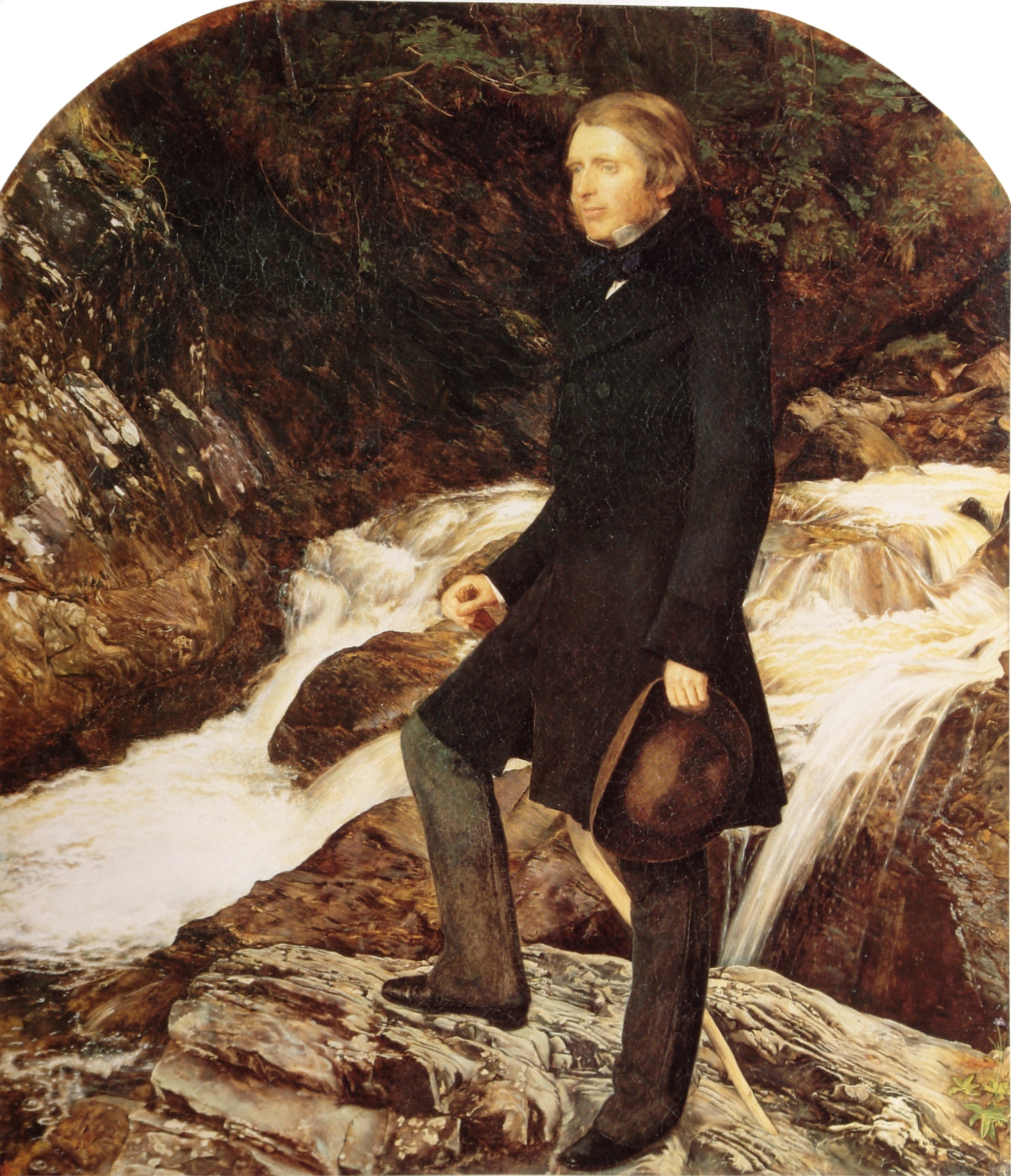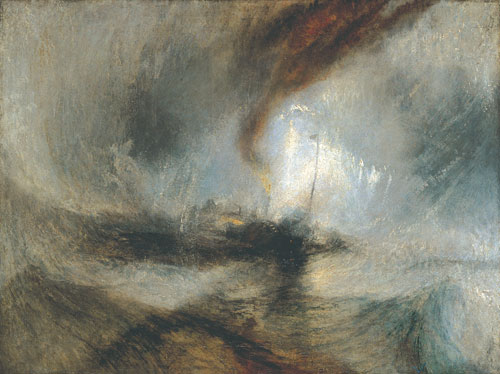John Ruskin had a big influence on Mahatma Gandhi, Marcel Proust, T.S. Eliot, Ezra Pound, Cecil Rhodes of Rhodesia fame, Oscar Wilde, Leo Tolstoy, Ezra Pound, Prime Minister Clement Attlee, Frank Lloyd Wright, Charlotte Brontë, Walter Gropius, Tom Stoppard, Thomas Cook, and William Makepeace Thackery. The Ruskin collection of Tokyo pearl magnate Ryuzo Mikimoto was so extensive that his children built a dedicated library to house it. Communes in places like Tennessee were founded in his honor while small towns in Florida and Nebraska bear his name. His love life was romantic and outré enough to inspire a recent Hollywood film starring Dakota Fanning. His works were translated in languages as diverse as Chinese, Hungarian, and Esperanto. If that isn’t enough, he planted the conceptual seed that grew into the British Labour Party. Not bad for a painter and professor of art.

Mrs. Ruskin a.k.a. Euphemia “Effie” Gray

Dakota Fanning in the rôle demon-
strates the power of modern
image processing.
The Gray family boasted three daughters so beautiful that they were the favorite subjects of fellow painter John Everett Millais. John Ruskin wrote a fairy tale for a twelve-year-old Euphemia Gray, she named after a saint devoured by Roman bears. The residents of a valley anger the spirits, who cause the river to dry up. After a series of quests by three lads of varying virtues, the waters are restored via a vortex.


Alice Gray Alice and Sophie Gray

John Ruskin in Scotland by John Everett Millais
The Ruskin parents were very wealthy merchants and had great ambitions for their progeny, but ambitions back then were of a very different nature. Dad wanted him to become poet laureate of England or Archbishop of Canterbury. They were disappointed with a painter and art critic, especially since John’s painting was more reminiscent of the stiff, lifeless work of Adolf Hilter than of Rembrandt. John first gained fame as a fan of William Turner, the first and perhaps only artist to use the vortex as a means of composition. Ruskin liked the wild energy of Turner’s paintings of natural disasters. This was a radical position in stuffy old England.

Snowstorm by William Turner
On the other hand he was outraged by the riotous fecundity of

Dante Gabriel Rossetti’s Venus Verticordia.
Ruskin felt it desecrated the “enormous power” of flowers. Of this a critic scoffed, “really if one were to listen to scandal about flowers, gardening would become impossible.”
More often it was Ruskin doing the scandalizing, as with his approval of Millais’

Christ In The House of His Parents
Charles Dickens accused Millais of portraying Mary as an alcoholic who looks
…so hideous in her ugliness that … she would stand out from the rest of the company as a Monster, in the vilest cabaret in France, or the lowest gin-shop in England.
This was in dramatic contrast to the familiar portrayal of a Danish Jesus, with his family and his apostles in costumes reminiscent of Roman togas. One critic complained that it was “painful” to see “the youthful Saviour” depicted as “a red-headed Jew boy.” Dickens described the youthful Christ as a “wry-necked, blubbering red-headed boy in a bed-gown, who appears to have received a poke…playing in an adjacent gutter”.[5] Because of the controversy, Queen Victoria asked for the painting to be taken to Buckingham Palace so that she could view it in private.[6] — Wikipedia
When Euphemia came of age she and John were married. Effie was a flirtatious socialite while John was a dour intellectual. It went about as well as the comparable Charles/Diana and Marilyn Monroe/Arthur Miller pairings, lasting six years. Effie said that John never consummated the marriage, but this may have been because that is what one must say to have a marriage annulled, which it was. Effie soon was in the arms of none other than her other admirer since childhood, painter John Everett Millais.
Viewing of the next classic painting affected Ruskin so strongly that he renounced Evangelical Christianity. Don’t ask me why.
Presentation of the Queen of Sheba.
Whussup wit dat? If you are like me, you are wondering, how did this weirdo inspire the British Labour Party? Don’t worry. He was just getting started.
Having gained fame as a controversial art critic and likely influenced by Karl Marx, Ruskin outraged society by advancing the radical proposition that labor has value and that getting your hands dirty was good for you.
However, its editor, William Makepeace Thackeray, was forced to abandon the series by the outcry of its largely conservative readership and the fears of a nervous publisher (Smith, Elder & Co.). The press reaction was hostile, and Ruskin was, he claimed, “reprobated in a violent manner”.[90] His father also strongly disapproved.[91] Others were enthusiastic, including Ruskin’s friend, Thomas Carlyle, who wrote, “I have read your paper with exhilaration… such a thing flung suddenly into half a million dull British heads… will do a great deal of good.”[92]
Ruskin’s political ideas, and Unto This Last in particular, later proved highly influential, praised and paraphrased in Gujarati by Mohandas Gandhi, the economist John A. Hobson and many of the founders of the British Labour party.[93].
Ruskin was unanimously appointed the first Slade Professor of Fine Art at Oxford University. He delivered his inaugural lecture to a larger-than-expected audience, stating that “The art of any country is the exponent of its social and political virtues.”. Thus, its effect on each man should be visible and moving.[108]Cecil Rhodes cherished a long-hand copy of the lecture, believing that it supported his own view of the British Empire.[109]
Ruskin however was hardly a communist. He maintained a very English view of the matter, which is what made his writings so influential. His views on social equality are almost identical to those of the USA’s General/President Andrew Jackson, who has seldom been accused of liberalism.
If there be any one point insisted on throughout my works more frequently than another, that one point is the impossibility of Equality. My continual aim has been to show the eternal superiority of some men to others, sometimes even of one man to all others; and to show also the advisability of appointing such persons or person to guide, to lead, or on occasion even to compel and subdue, their inferiors, according to their own better knowledge and wiser will.
— Cook and Wedderburn 7.207 and 17.25
Most controversial, from the point of view of the University authorities, spectators and the national press, was the digging scheme on Ferry Hinksey Road which involved undergraduates in road-mending.[114] Motivated in part by a desire to teach the virtues of wholesome manual labour, some of the diggers including Oscar Wilde, were profoundly influenced by the experience—notably Arnold Toynbee, Leonard Montefiore and Alexander Robertson MacEwen. It helped to foster a public service ethic that was later given expression in the university settlements,[115] and was keenly celebrated by the founders of Ruskin Hall, a small independent college in Oxford.[116]In 1879, Ruskin resigned from Oxford, but resumed his Professorship in 1883, resigning again in 1884.[117] He gave his reason as opposition to vivisection,[118] but he had increasingly been in conflict with the University authorities, who refused to expand his Drawing School.[111] He was also suffering increasingly poor health.

Whistler filed a libel suit against Ruskin. Whistler won the case, which went to trial in Ruskin’s absence in 1878 (he was ill), but the jury awarded damages of only one farthing to the artist. Court costs were split between both parties. Ruskin’s were paid by public subscription, but Whistler was bankrupted within six months. The episode tarnished Ruskin’s reputation, however, and may have accelerated his mental decline.[121]
He wrote codes of practice, described styles of dress and even designed the Guild’s own coins.[3] He also wished to establish St George’s Schools, but the schools, like the dress and coins, never materialised. In part, this is because soon after Ruskin started the Guild he began to show signs of emotional disturbance and in 1878 suffered the first of a series of mental breakdowns that increasingly limited his activity.[4] In reality, the Guild has always operated on a modest scale, its activities being suggestive rather than transformational.
Things got weird.
Maria La Touche, a minor Irish poet and novelist but of wealth, asked Ruskin to teach her daughters drawing and painting. Rose La Touche was ten, Ruskin nearly 39. Ruskin gradually fell in love with her. Their first meeting came at a time when Ruskin’s own religious faith was under strain. This always caused difficulties for the staunchly Protestant La Touche family who at various times prevented the two from meeting.[137] Ruskin’s love for Rose was a cause alternately of great joy and deep depression for him, and always a source of anxiety.[138] Ruskin proposed to her on or near her eighteenth birthday in 1867, but she asked him to wait three years for an answer, until she was 21. After having Ruskin wait two additional years she finally rejected him. Rose fell into a long illness and four years later died. These events plunged Ruskin into despair and led to increasingly severe bouts of mental illness involving a number of breakdowns and delirious visions. Ruskin turned to spiritualism and was by turns comforted and disturbed by what he believed was his ability to communicate with the dead Rose.
Having been in style most of his adult life, the times began to pass John by. He became passé.
His ideas on the social utility of art contrasted with the “l’art pour l’art” or “art for art’s sake” that was beginning to dominate. His later writings were increasingly seen as irrelevant.
But by no means completely.
A number of Utopian socialist Ruskin Colonies attempted to put his political ideals into practice. These communities included Ruskin, Florida, Ruskin, British Columbia and the Ruskin Commonwealth Association, a colony which existed in Dickson County, Tennessee.
Was it entirely the value of his ideas that brought John fame? Maybe, but a huge inheritance equal to many millions of today’s pounds didn’t hurt. It enabled John to endow his Drawing School at Oxford and his other charitable works. Ain’t no rule again using Daddy’s money. It worked for Gautama Buddha. John continued the family business of selling tea, albiet on a modest scale. He refused to live as a gentleman of leisure. This was the act of a rebel.

